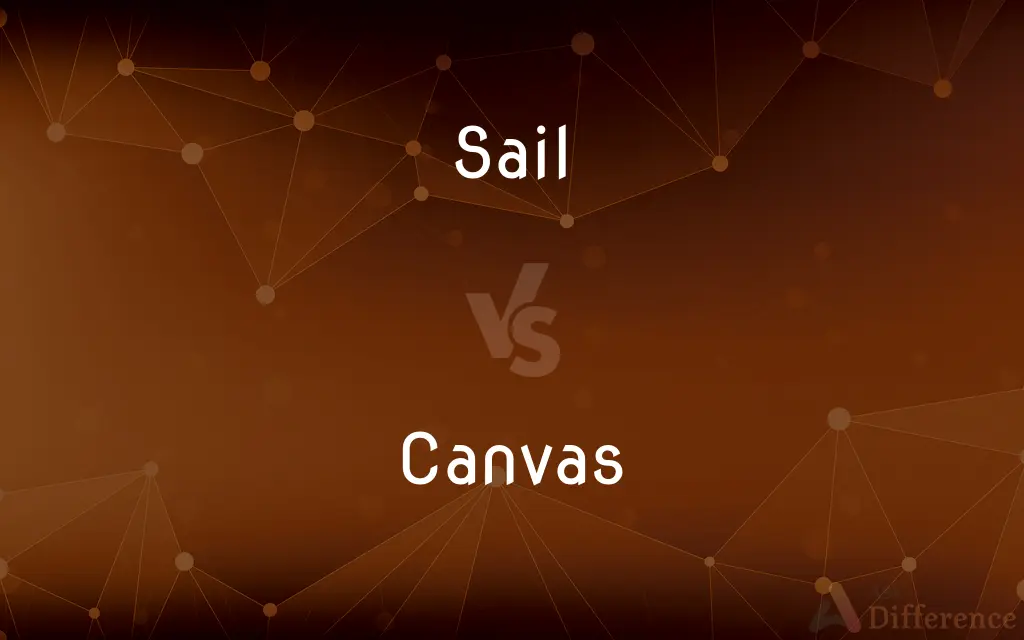Sail vs. Canvas — What's the Difference?
Edited by Tayyaba Rehman — By Maham Liaqat — Updated on March 27, 2024
Sail refers to a piece of material used to catch the wind and propel a vessel, whereas canvas is a durable fabric used for making sails and other items.

Difference Between Sail and Canvas
Table of Contents
ADVERTISEMENT
Key Differences
A sail is specifically designed for use on a vessel to catch the wind, allowing it to move across water. It is a crucial component of sailboats, yachts, and sailing ships. On the other hand, canvas is a heavy-duty fabric known for its sturdiness and versatility, used not only for sails but also for tents, marquees, backpacks, and as a painting surface for artists.
Sails are tailored to various sizes and shapes to suit different types of vessels and sailing conditions. They can be made from various materials, including canvas, polyester, and laminated membranes, depending on the required performance, durability, and cost. Canvas, however, is traditionally made from hemp, flax, or cotton, and its use extends beyond sailing to include fashion, art, and industrial applications.
The primary function of a sail is to convert the wind's energy into propulsive force, effectively driving a vessel forward or changing its course. Canvas, while often associated with sails, serves multiple functions across different contexts, including providing shelter, protective coverings, and a medium for artistic expression.
Technological advancements have led to the development of modern sail materials that offer superior strength, efficiency, and longevity compared to traditional canvas. Despite these innovations, canvas remains a popular choice for its aesthetic appeal and historical significance in sailing.
While the terms sail and canvas can be interconnected, especially in maritime contexts, it's essential to distinguish between a sail's specific purpose for navigation and canvas as a versatile material with a wide range of applications.
ADVERTISEMENT
Comparison Chart
Definition
A piece of material used to catch wind for propulsion.
A durable fabric used in making sails and other items.
Primary Use
Propelling sailboats, yachts, and sailing ships.
Making sails, tents, bags, and as a painting surface.
Material
Can be made from canvas, polyester, or laminated membranes.
Traditionally made from hemp, flax, or cotton.
Function
To convert wind's energy into propulsive force.
Versatile; used for shelter, storage, and artistic mediums.
Technological Evolution
Modern sails use advanced materials for improved performance.
Canvas use remains widespread, valued for its durability and aesthetic.
Compare with Definitions
Sail
A material piece designed to catch wind for vessel propulsion.
The boat unfurled its sail and headed into the wind.
Canvas
Material for oil painting.
The artist stretched a new canvas for her next piece.
Sail
A trip or journey by water.
We planned a sail around the bay.
Canvas
A strong, durable fabric used for making sails and tents.
The tent was made of waterproof canvas.
Sail
Used metaphorically to represent travel or progress.
With her new degree, she's ready to set sail on her career.
Canvas
Used figuratively to denote an area for creative work.
The city streets became a canvas for the mural festival.
Sail
An act of sailing a vessel.
The afternoon sail was peaceful and calm.
Canvas
Heavy cloth used for coverings.
They covered the equipment with canvas to protect it from the rain.
Sail
To move smoothly and swiftly.
The skateboarder sailed down the street.
Canvas
An expanse of canvas fabric.
The ship's canvas billowed in the strong wind.
Sail
A sail is a tensile structure—made from fabric or other membrane materials—that uses wind power to propel sailing craft, including sailing ships, sailboats, windsurfers, ice boats, and even sail-powered land vehicles. Sails may be made from a combination of woven materials—including canvas or polyester cloth, laminated membranes or bonded filaments—usually in a three- or four-sided shape.
Canvas
Canvas is an extremely durable plain-woven fabric used for making sails, tents, marquees, backpacks, shelters, as a support for oil painting and for other items for which sturdiness is required, as well as in such fashion objects as handbags, electronic device cases, and shoes. It is also popularly used by artists as a painting surface, typically stretched across a wooden frame.
Sail
A piece of material extended on a mast to catch the wind and propel a boat or ship or other vessel
All the sails were unfurled
The boat can no longer carry that area of sail
Canvas
A strong, coarse unbleached cloth made from hemp, flax, or a similar yarn, used to make items such as sails and tents and as a surface for oil painting
The painting is oil on canvas
A canvas bag
Sail
A wind-catching apparatus attached to the arm of a windmill.
Canvas
Cover with canvas
The door had been canvassed over
Sail
A voyage or excursion in a ship, especially a sailing ship or boat
They went for a sail
Canvas
A heavy, coarse, closely woven fabric of cotton, hemp, or flax, traditionally used for tents and sails.
Sail
The conning tower of a submarine.
Canvas
A piece of such fabric on which a painting, especially an oil painting, is executed.
Sail
A canvas sheet or tarpaulin
The sail covering the load of crates broke loose from the truck
Canvas
A painting executed on such fabric.
Sail
Travel in a boat with sails, especially as a sport or recreation
Ian took us out sailing on the lake
Canvas
A fabric of coarse open weave, used as a foundation for needlework.
Sail
Move smoothly and rapidly or in a stately or confident manner
The ball sailed inside the right-hand post
Canvas
The background against which events unfold, as in a historical narrative
A grim portrait of despair against the bright canvas of the postwar economy.
Sail
A piece of fabric sewn together and fitted to the spars and rigging of a vessel so as to convert the force of the wind into forward motion of the vessel.
Canvas
(Nautical) A sail or set of sails.
Sail
The sails of a ship or boat.
Canvas
A tent or group of tents.
Sail
A narrow fairwater supporting the bridge of a submarine.
Canvas
A circus tent.
Sail
Pl. sail or sails Nautical A sailing vessel.
Canvas
(Sports) The floor of a ring in which boxing or wrestling takes place.
Sail
(Nautical) A trip or voyage in a sailing craft.
Canvas
A type of coarse cloth, woven from hemp, useful for making sails and tents or as a surface for paintings.
Sail
Something, such as the blade of a windmill, that resembles a sail in form or function.
Canvas
(painting)
Sail
To move across the surface of water, especially by means of a sailing vessel.
Canvas
A piece of canvas cloth stretched across a frame on which one may paint.
Sail
To travel by water in a vessel.
Canvas
A painting, or a picture on canvas.
Sail
To start out on such a voyage or journey
Tomorrow we sail for the islands.
Canvas
A mesh of loosely woven cotton strands or molded plastic to be decorated with needlepoint, cross-stitch, rug hooking, or other crafts.
Sail
To operate a sailing craft, especially for sport.
Canvas
(figuratively) A basis for creative work.
The author takes rural midwestern life as a canvas for a series of tightly woven character studies
Sail
To move along or progress smoothly or effortlessly
Sailed into the room five minutes late.
Sailed through the exam.
Sailed through the red light.
Canvas
(computer graphics) A region on which graphics can be rendered.
Sail
To move along through the air
The ball sailed into the stands.
Canvas
(nautical) Sails in general.
Sail
To navigate or manage (a vessel).
Canvas
A tent.
He spent the night under canvas.
Sail
To voyage upon or across
Sail the Pacific.
Canvas
A rough draft or model of a song, air, or other literary or musical composition; especially one to show a poet the measure of the verses he is to make.
Sail
(nautical) A piece of fabric attached to a boat and arranged such that it causes the wind to drive the boat along. The sail may be attached to the boat via a combination of mast, spars and ropes.
Canvas
(Nigeria) Athletic shoes.
Sail
The concept of a sail or sails, as if a substance.
Take in sail: a storm is coming.
Canvas
Obsolete spelling of canvass
Sail
(uncountable) The power harnessed by a sail or sails, or the use of this power for travel or transport.
Canvas
(transitive) To cover (an area or object) with canvas.
Sail
A trip in a boat, especially a sailboat.
Let's go for a sail.
Canvas
Obsolete spelling of canvass
Sail
A sailing vessel; a vessel of any kind; a craft.
Twenty sail were in sight.
Canvas
A strong cloth made of hemp, flax, or cotton; - used for tents, sails, etc.
By glimmering lanes and walls of canvas led.
Sail
(nautical) The conning tower of a submarine.
Canvas
A coarse cloth so woven as to form regular meshes for working with the needle, as in tapestry, or worsted work.
History . . . does not bring out clearly upon the canvas the details which were familiar.
Sail
The blade of a windmill.
Canvas
Something for which canvas is used: (a) A sail, or a collection of sails. (b) A tent, or a collection of tents. (c) A painting, or a picture on canvas.
To suit his canvas to the roughness of the see.
Light, rich as that which glows on the canvas of Claude.
Sail
A tower-like structure found on the dorsal (topside) surface of submarines.
Canvas
A rough draft or model of a song, air, or other literary or musical composition; esp. one to show a poet the measure of the verses he is to make.
Sail
The floating organ of siphonophores, such as the Portuguese man-of-war.
Canvas
Made of, pertaining to, or resembling, canvas or coarse cloth; as, a canvas tent.
Sail
(fishing) A sailfish.
We caught three sails today.
Canvas
Heavy closely woven fabric (used for clothing or chairs or sails or tents)
Sail
(paleontology) an outward projection of the spine, occurring in certain dinosaurs and synapsids
Canvas
An oil painting on canvas
Sail
Anything resembling a sail, such as a wing.
Canvas
The setting for a narrative or fictional or dramatic account;
The crowded canvas of history
The movie demanded a dramatic canvas of sound
Sail
To be impelled or driven forward by the action of wind upon sails, as a ship on water; to be impelled on a body of water by steam or other power.
Canvas
A tent made of canvas
Sail
To move through or on the water; to swim, as a fish or a waterfowl.
Canvas
A large piece of fabric (as canvas) by means of which wind is used to propel a sailing vessel
Sail
To ride in a boat, especially a sailboat.
Canvas
The mat that forms the floor of the ring in which boxers or professional wrestlers compete;
The boxer picked himself up off the canvas
Sail
(intransitive) To set sail; to begin a voyage.
We sail for Australia tomorrow.
Canvas
Solicit votes from potential voters in an electoral campaign
Sail
To move briskly and gracefully through the air.
Canvas
Get the opinions (of people) by asking specific questions
Sail
(intransitive) To move briskly but sedately.
The duchess sailed haughtily out of the room.
Canvas
Cover with canvas;
She canvassed the walls of her living room so as to conceal the ugly cracks
Sail
To deal out (cards) from a distance by impelling them across a surface.
Canvas
Consider in detail and subject to an analysis in order to discover essential features or meaning;
Analyze a sonnet by Shakespeare
Analyze the evidence in a criminal trial
Analyze your real motives
Sail
An extent of canvas or other fabric by means of which the wind is made serviceable as a power for propelling vessels through the water.
Behoves him now both sail and oar.
Sail
Anything resembling a sail, or regarded as a sail.
Sail
A wing; a van.
Like an eagle soaringTo weather his broad sails.
Sail
The extended surface of the arm of a windmill.
Sail
A sailing vessel; a vessel of any kind; a craft.
Sail
A passage by a sailing vessel; a journey or excursion upon the water.
Sail
To be impelled or driven forward by the action of wind upon sails, as a ship on water; to be impelled on a body of water by the action of steam or other power.
Sail
To move through or on the water; to swim, as a fish or a water fowl.
Sail
To be conveyed in a vessel on water; to pass by water; as, they sailed from London to Canton.
Sail
To set sail; to begin a voyage.
Sail
To move smoothly through the air; to glide through the air without apparent exertion, as a bird.
As is a winged messenger of heaven, . . .When he bestrides the lazy pacing clouds,And sails upon the bosom of the air.
Sail
To pass or move upon, as in a ship, by means of sails; hence, to move or journey upon (the water) by means of steam or other force.
A thousand ships were manned to sail the sea.
Sail
To fly through; to glide or move smoothly through.
Sublime she sailsThe aërial space, and mounts the wingèd gales.
Sail
To direct or manage the motion of, as a vessel; as, to sail one's own ship.
Sail
A large piece of fabric (as canvas) by means of which wind is used to propel a sailing vessel
Sail
An ocean trip taken for pleasure
Sail
Traverse or travel by ship on (a body of water);
We sailed the Atlantic
He sailed the Pacific all alone
Sail
Move with sweeping, effortless, gliding motions;
The diva swept into the room
Shreds of paper sailed through the air
The searchlights swept across the sky
Sail
Travel in a boat propelled by wind;
I love sailing, especially on the open sea
Sail
Travel by boat on a boat propelled by wind or by other means;
The QE2 will sail to Southampton tomorrow
Common Curiosities
How are sails made?
Sails are made from materials like canvas, polyester, or laminated membranes, tailored to suit different sailing conditions.
Why is canvas popular for sails?
Canvas is valued for its durability, strength, and traditional aesthetic in sailing applications.
What's the difference between sailing and canvas?
Sailing refers to the act or skill of moving a boat by using sails, while canvas is a material that can be used to make sails among other things.
How does the function of a sail differ from other uses of canvas?
A sail's specific function is to catch wind for propulsion, while canvas can serve multiple purposes, including as a medium for artistic expression or as protective coverings.
What is canvas?
Canvas is a durable fabric used for making sails, tents, bags, and as a medium for painting.
Can canvas be used for things other than sails?
Yes, canvas is also used for tents, bags, as a painting surface, and in various industrial applications.
What is a sail?
A sail is a material piece designed to catch the wind, propelling vessels like sailboats and yachts.
What materials are used to make modern sails?
Modern sails might use advanced materials like laminated membranes or polyester for enhanced performance.
Is canvas only made from cotton?
No, canvas can be made from hemp, flax, or cotton, depending on its intended use and desired characteristics.
Why do artists use canvas?
Artists use canvas for its texture and durability, which is ideal for oil and acrylic painting.
What roles does canvas play outside of sailing?
Canvas is used in a variety of applications outside sailing, including fashion, art, and manufacturing protective coverings.
Can the term "sail" be used metaphorically?
Yes, "sail" can metaphorically represent progress, travel, or embarking on new ventures.
How do technological advancements affect sail making?
Technological advancements have led to the development of sails with superior strength, efficiency, and durability compared to traditional materials.
Can a sail be made from materials other than canvas?
Yes, sails can also be made from synthetic materials like polyester, which offer different performance characteristics.
Are all sails made from canvas today?
Not all sails are made from canvas today; many modern sails use synthetic materials for better performance and durability.
Share Your Discovery

Previous Comparison
Workmate vs. Colleague
Next Comparison
Loop vs. MeshAuthor Spotlight
Written by
Maham LiaqatEdited by
Tayyaba RehmanTayyaba Rehman is a distinguished writer, currently serving as a primary contributor to askdifference.com. As a researcher in semantics and etymology, Tayyaba's passion for the complexity of languages and their distinctions has found a perfect home on the platform. Tayyaba delves into the intricacies of language, distinguishing between commonly confused words and phrases, thereby providing clarity for readers worldwide.
















































